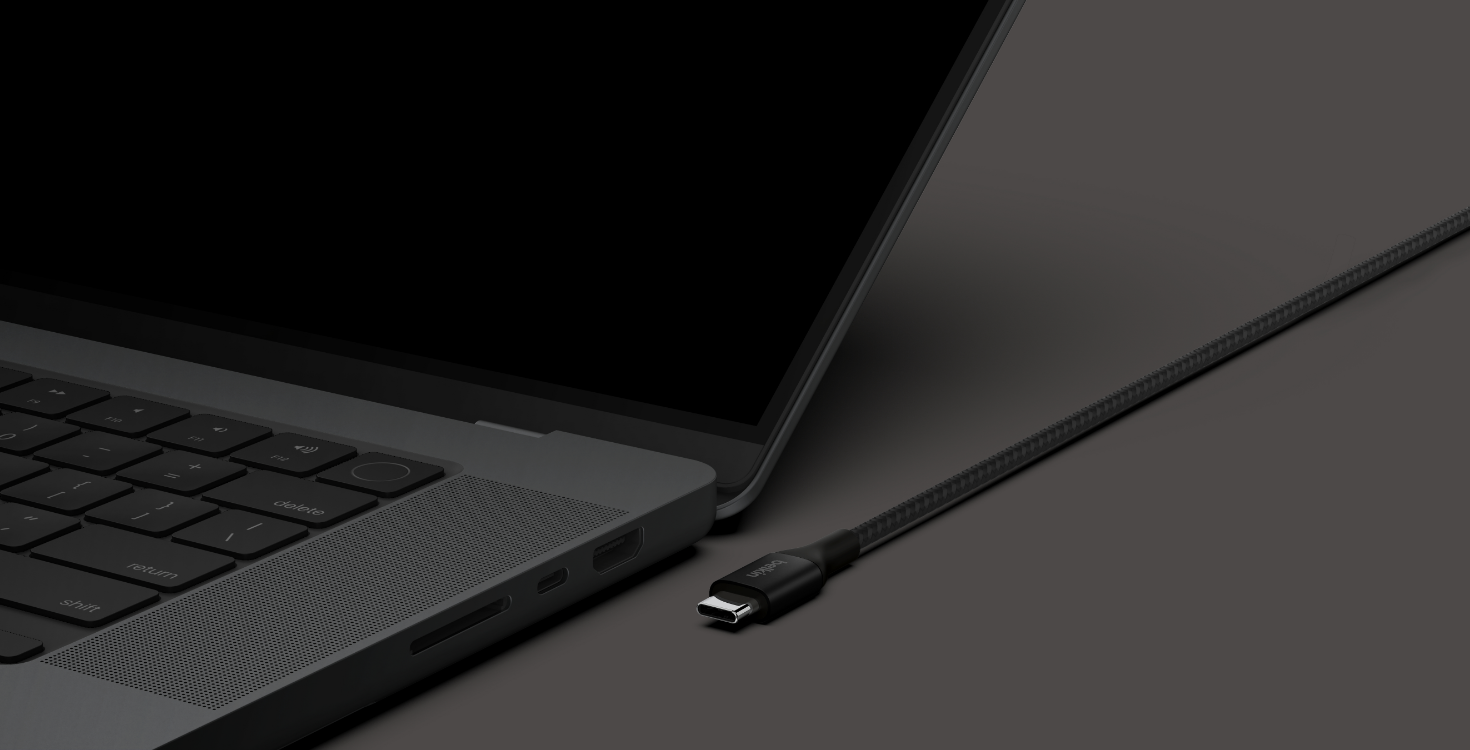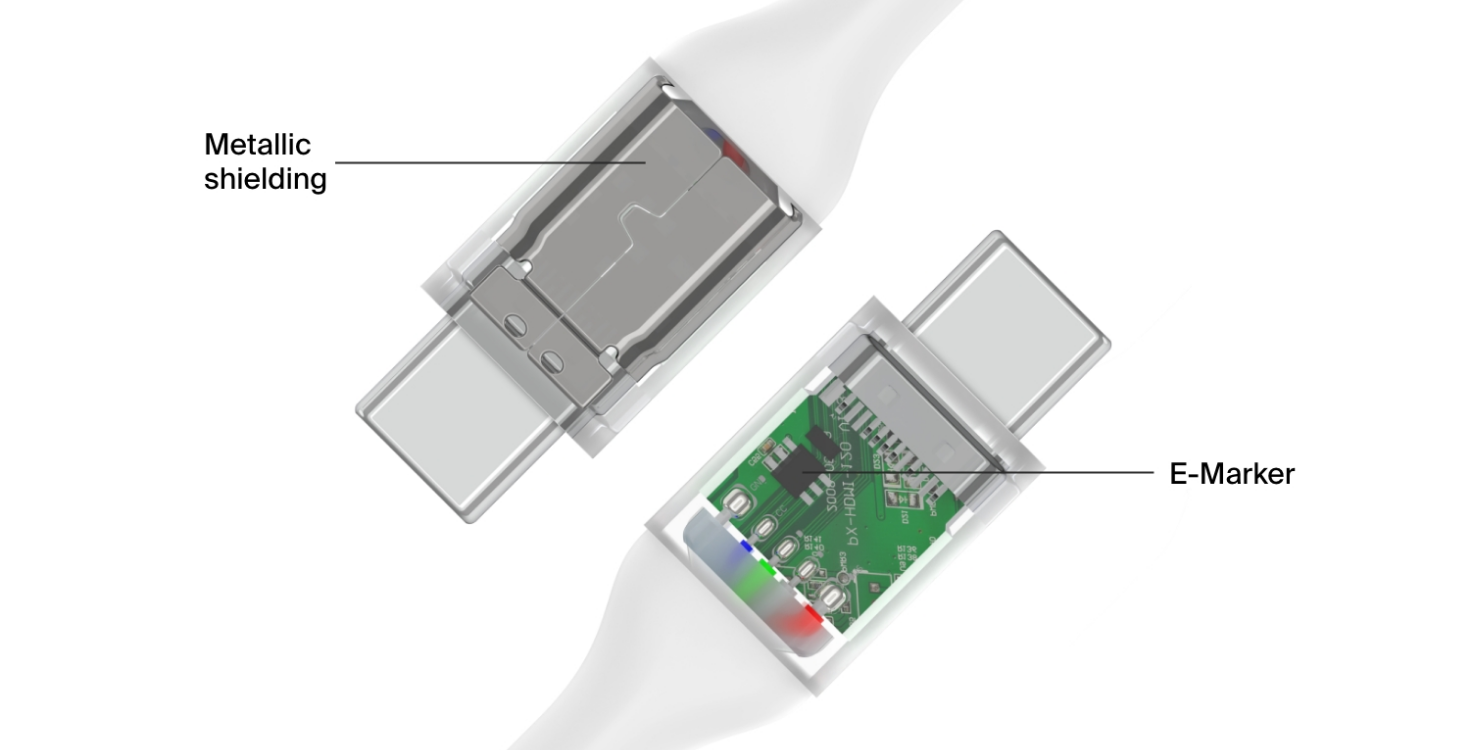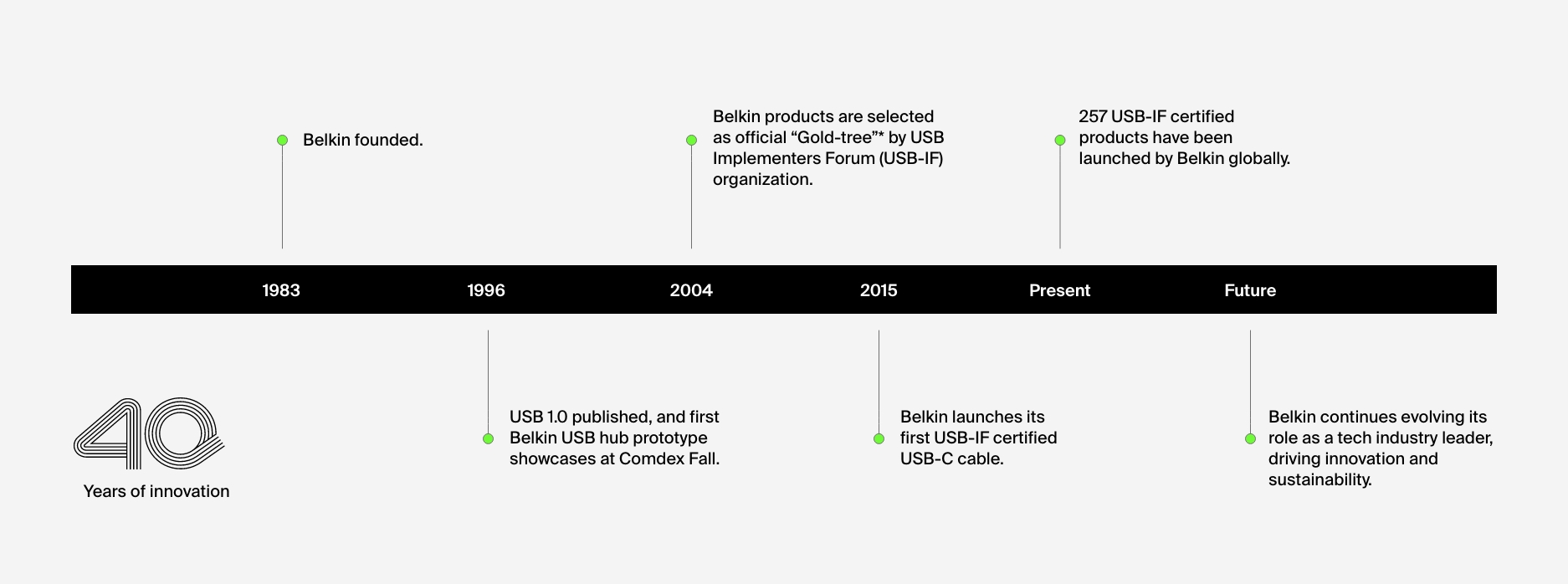You had to USB-there! Everything you need to know about USB-C cables and what to look for when shopping for one.
September 28, 2023

More than just a simple port, USB-C (or USB Type-C) is a modern feat in engineering. This standard offers high power, speedy data transfer and a symmetrical, reversible design that makes it extremely user-friendly… amongst many other advantages. This new protocol didn’t appear overnight, and it has taken decades of technological advancements to become the USB-C we know today.
In this article you will learn about:
- USB standard history
- Ho to choose a high-quality USB-C cable
- Benefits of USB-C cables
- Smartphones and devices compatible with USB-C cables & more.
A USB standard history crash course.
Developed nearly 30 years ago, the USB standard was the starting point for the USB-C we know today.
Most technology users will have heard the term “USB” – also known as a universal serial bus, a plug-and-play technology standard that was designed to standardize and simplify the way we connect attachments from peripheral devices to a computer. Not only easy to use but multifunctional too – USB technology handles communication from a computer to a peripheral as well as a power supply. When it entered the market in 1996, the USB standard levelled the playing field and helped alleviate the need to develop individual interfaces for each new peripheral that entered the market. It created one universal port that could accommodate a multitude of technologies.
The USB standard was a major moment in technology history. Prior, attaching peripherals to a computer required a variety of cables and ports, as each manufacturer used their own. More ports to work with meant more fragmentation in the market, requiring a wider variety of cables. As technology developed and became more advanced over time, new USB types rose to meet the market’s ever-changing needs.
What is the USB-IF?
You may have heard of the USB-IF – otherwise known as the USB Implementers Forum. This nonprofit organization was created to promote and maintain USB standards. Belkin was an early adopter of this technology and had its first involvement with the USB-IF nearly 30 years ago. In fact, Belkin was the first to introduce technologies like USB PCI cards, USB serial adapters, and USB PS2 adapters.
Belkin journey with USB-C.
Belkin engineers collaborated with the USB-IF to develop the USB-C protocol from 2012 through 2014. The first Belkin USB-C product was launched in 2015 and was a USB-A to USB-C cable. USB-C offered a new type of connector shape, a 24-pin system that is compact and easier to use than the traditional USB-A, a long-standing industry standard. Its reversible design means there’s no wrong way to plug in, and it’s more powerful too. USB-C can support new USB advancements like USB 3.1 and USB power delivery (USB PD) -- a fast charging technology supported by certain iOS/Apple and Android/Google/Samsung devices that delivers much higher levels of power than standard charging.
With USB-C now firmly in the market, this new era in peripheral technology began to gain traction. Unfortunately, a flood of non-compliant cables showed up at the party too. Benson Leung, an ex-Google engineer and USB-C pioneer, is famously known for reviewing USB-C cables for safety and specification compliance. Benson performed tests across a spectrum of branded (and non-branded) USB-C cables to learn which producers are dependable when it comes to USB-C.
Benson learned that by not using cables up to spec, you run the risk of damaging your hardware in both the short and long term. Many producers were putting products out that looked like USB-C but didn’t follow the necessary standards and protocols. With his work, Benson raised awareness of the possible risks and prevalence of non-compliant cables in the market, for both consumers and the wider industry at large. Unfortunately for Benson, during his testing, he permanently damaged his laptop with a cable that did not adequately meet the specification standards. Benson is quoted in this research paper, published in 2015.

What to look for in USB-C charging testing and specs.
- Due to the high-power delivery, Belkin 100w USB-C uses a single E-marker, i.e., a chipset built into the cable head to ensure charging safety. It describes each cable’s characteristics, including the maximum power load it can carry. The chip is electrically shielded in metal housing and then sealed within a thermoplastic grip. Our latest 240W C-C cable is made with a dual E-marker.
- Meticulously designed metallic shielding in the cable head enhances durability. The function of the metallic shielding is to mount the connector, cable boot and raw cable together, to avoid the situation where the connector gets stuck in the device when pulling the cable out.
- With raw cable design, Belkin USB-C cables feature added Nylon wire to the cable to enhance the tensile strength.
- We ensure radiation and EMI isolation with multilayer metallic/graphene shielding.
- The industrial design team at Belkin makes sure our Type-C receptacle is the best form factor, matching the internal tongue color to the product and designing the slimmest enclosure size.
- All Belkin USB-C cables are tested & certified to USB-IF standards and compatibility tested for best-selling mobile phones. For example, the wireless de-sense test.
- Belkin USB-C cables support PD at 60W or up to 240W (*C-C cable).
- Plus, they offer up to 25,000 to 30,000 bends (CAB-series) and follow iSO14001 standard.
Why choose Belkin USB-C?
- Belkin’s first certified Type-C product was released in November 2015, and we’ve regularly released cables and other types of products since.
- An expert in this area of the market, Belkin has been working with this technology for the past several years. You can even say we had a hand in building it. Belkin collaborated with USB-IF (USB Implementers Forum) to create the USB standard and worked to educate consumers, which we will continue to do. USB-IF has chosen Belkin products as the official selection for its ‘Gold-tree’, a trusted list of USB devices used to ensure compatibility and functionality.
- Because Belkin has often been part of the founding class of tech transitions helping to set new protocols (USB-IF, WPC, etc.), we embrace these evolutions and are able to prepare for them well before the rest of the market.
- Belkin has regularly attended USB-IF PlugFest events in past years, where USB-C products are tested for quality and functionality.
- We believe in delivering our customers the best experience, and given our commitment to quality, we will continue to bring products to market that pass the highest safety and usage certifications.
Frequently asked questions (FAQs)
What type of mobile phones support USB-C?
The world’s most popular mobile devices support USB-C. This includes the latest iPhone 15 lineup, Samsung Galaxy devices, and Google Pixel models.
What are the benefits of USB-C cables?
USB-C cables offer several benefits that make them a versatile and convenient choice for connecting and charging various devices. Here are some of the key benefits of USB-C cables:
- Reversible Design: USB-C cables feature a reversible design, which means they can be plugged in any direction, unlike older USB connectors like USB-A or USB-B. This makes it much easier to connect devices without worrying about the orientation of the cable.
- Universal Compatibility: USB-C is a widely adopted standard that supports multiple protocols, including USB 2.0, USB 3.0, USB 3.1, USB 4, Thunderbolt, DisplayPort, HDMI, and Power Delivery (PD). This universal compatibility allows USB-C cables to work with a wide range of devices, from smartphones and tablets to laptops, gaming consoles, and more.
- High Data Transfer Speeds: Depending on the version of the USB-C standard and the supported protocol, USB-C cables can offer high data transfer speeds. USB 3.1 Gen 1 (USB 3.0) provides up to 5 Gbps, while USB 3.1 Gen 2 can reach up to 10 Gbps. USB 4 can achieve even faster speeds, up to 40 Gbps.
- Fast Charging: USB-C cables support Power Delivery (PD), a technology that allows devices to negotiate power requirements and deliver higher levels of power. This enables faster charging for smartphones, tablets, laptops, and other compatible devices. With USB-C PD, you can charge your devices more quickly compared to standard USB cables.
- Versatility in Audio and Video: USB-C can carry audio and video signals, supporting technologies like DisplayPort and HDMI. This means you can connect your devices to external displays, monitors, projectors, or TVs using a single USB-C cable, simplifying connectivity.
- Compact and Slim Design: USB-C connectors are compact and slim, making them ideal for slim devices like smartphones and ultrabooks. The reduced size allows manufacturers to create thinner and more lightweight devices without sacrificing functionality.
- Support for Alternate Modes: USB-C supports alternate modes, which means it can be adapted to various functionalities, such as Thunderbolt 3 for high-speed data transfer and video output or USB-C Alt Mode for DisplayPort and HDMI connections.
- One Cable for Multiple Devices: With USB-C, you can use a single cable to charge multiple devices, reducing the number of cables you need to carry. For instance, a USB-C charger can power a laptop, smartphone, and other peripherals using compatible USB-C ports.
- Futureproofing: As USB-C becomes more ubiquitous, it is likely to remain the standard for future devices. Investing in USB-C cables now ensures that you will have cables that work with upcoming devices and technologies.
Overall, USB-C cables offer a combination of speed, versatility, and convenience, making them an excellent choice for connecting and charging a wide range of devices in the modern digital ecosystem. However, it's essential to ensure that the USB-C cables you use are of good quality and certified by reputable organizations to avoid potential compatibility or safety issues.
What devices can USB-C cables charge?
- Phones (e.g., Apple, Samsung, Google)
- Tablets (e.g., Apple, Samsung, Amazon)
- Laptops (e.g., Apple, Lenovo, Dell)
- Cameras (e.g., Panasonic, Nikon, Canon)
- Headphones (e.g., Apple, Samsung, Belkin)
- Power banks (e.g., Belkin (do we want to feature other brands?)
- Gaming consoles (e.g., Nintendo Switch)
How to choose the right USB-C cable for your new phone?
Choosing the right USB-C cable for your phone is essential to ensure safe and efficient charging and data transfer. Here are 10 factors to consider when selecting a USB-C cable:
- USB-C Version and Speed: USB-C cables come in different versions, such as USB 2.0, USB 3.1 Gen 1 (USB 3.0), USB 3.1 Gen 2, and USB 4. The version determines the data transfer speeds the cable can support. If you need faster data transfer, make sure to choose a cable that matches your device's capabilities.
- Charging Speed and Power Delivery (PD): If you want faster charging for your phone, ensure that the cable supports Power Delivery (PD). PD allows devices to negotiate higher power levels for faster charging. Look for a cable that can handle the required power output for your phone and charger.
- Cable Length: Consider how long you need the cable to be. Longer cables provide more flexibility but may result in slightly slower charging speeds due to resistance over longer distances.
- Quality and Certification: Choose a high-quality USB-C cable from reputable brands or certified manufacturers. Look for cables that are USB-IF certified (USB Implementers Forum) or compliant with relevant safety standards to ensure they meet quality and safety requirements.
- Data and Charging Compatibility: Ensure the cable is compatible with your specific phone model and any other devices you plan to connect. Some USB-C cables may be designed for specific devices or have limitations on data transfer or charging capabilities. See below chart for details.
- Durable and Tangle-Free Design: Look for cables with sturdy construction and materials to withstand regular use and avoid tangling. Reinforced connectors and braided cables can enhance durability.
- Device Protection Features: Some USB-C cables come with built-in features to protect your device from overcharging, overheating, and power surges. These safety features can prevent potential damage to your phone.
- Brand Reputation and Reviews: Check customer reviews and ratings for the USB-C cable you are considering. Positive reviews from other users can provide insights into the cable's performance and durability.
- Budget: While it's essential to choose a high-quality cable, consider your budget as well. High-end cables may offer advanced features, but there are often reliable mid-range options available too.
- Warranty and Customer Support: Check if the cable comes with a warranty or customer support in case of any issues or defects.
Keep in mind that using substandard or low-quality USB-C cables can pose safety risks, potentially damaging your device or causing electrical hazards. It's advisable to avoid cheap, unbranded cables of unknown origin and instead opt for reputable and certified options from reliable manufacturers.
Are all USB-C cables the same?
No, not all USB-C cables are the same. There are different versions of USB-C cables with varying capabilities, such as USB 2.0, USB 3.0, USB 3.1, and USB 3.2 and USB4. There are also proprietary protocols designed by different brands to mark the differences in USB-C cables. Additionally, some cables may support features like video output or power delivery, while others may not. Bear in mind that some USB-C cables in the market are designed solely for charging purposes and may lack the necessary wires or circuitry to support data transfer. These cables are commonly referred to as "charging cables" and may not be suitable for transferring data. However, all “charging cables” from Belkin are USB 2.0 cables that support data transfer speeds up to 480 Mbps.
What is the difference between USB2.0 and USB3.2?
USB2.0 has a maximum data transfer speed of 480Mbps, while USB3.2 can reach up to 20Gbps. USB3.2 is backward compatible with USB2.0.
What is USB Power Delivery (PD)?
USB Power Delivery (PD) is a charging standard that allows for higher power delivery through USB-C cables. It enables faster charging of devices, including laptops, tablets, and smartphones, by negotiating the appropriate power level between the power source and the device. It supports power levels ranging from 5 watts to up to 100 watts with PD3.0 and below, and enables power delivery of up to 240 watts with the USB PD 3.1 specification.
What is Thunderbolt in USB-C charging?
Thunderbolt is a hardware interface that supports high-speed data transfer and peripheral connection technology developed by Intel. Thunderbolt technology is integrated into some USB-C ports, allowing for fast data transfer, video output, and power delivery capabilities. Symbol used on Thunderbolt ports and cables is a downward-facing arrow with a tail of lightning.
Does Thunderbolt support faster charging speeds compared to regular USB-C?
Thunderbolt itself does not inherently support faster charging speeds than regular USB-C. The charging speed depends on the power delivery capabilities of the USBC cable, device and charger being used.
What is an E-Marker inside the cable?
E-marker (electronic marker) is a chip that is used in USB-C cable, to communicate between power source and power sink devices. An E-marker is required on all USB Type-C cables that support 5A.
Can I use a USB-C cable for both charging and data transfer?
Yes, every certified cable can, at a minimum, pass data at 480 Mbps and provide 15W power. Popular applications can be divided in two ways, charging devices with minimal to no data transfer needs. Examples of these charging cables include:
- BoostCharge USB-C to USB-C Cable 60W
- BoostCharge USB-C to USB-C Cable 100W
- BoostCharge USB-C to USB-C Cable 240W
And combining charging devices with high data transfer needs, such as connecting a laptop to a workstation dock or connecting a laptop to a monitor such as Apple Studio Display. Examples of these computer cables include:
- 3.1 USB-C to USB-C Cable - 3.3ft/1m, 10Gbps
- USB4 Cable - 2.6ft, 40Gbps 100W USB4 Type C Cable
- Thunderbolt 4 Cable - 100W Charging, 8K Video
There are also hybrid USB-C cables that combine popular USB-C connection with HDMI and DisplayPort. Examples of these A/V cables include:
We hope you enjoyed this post. Signup for blog alerts, product announcements, and exclusive deals via emails and texts now.


